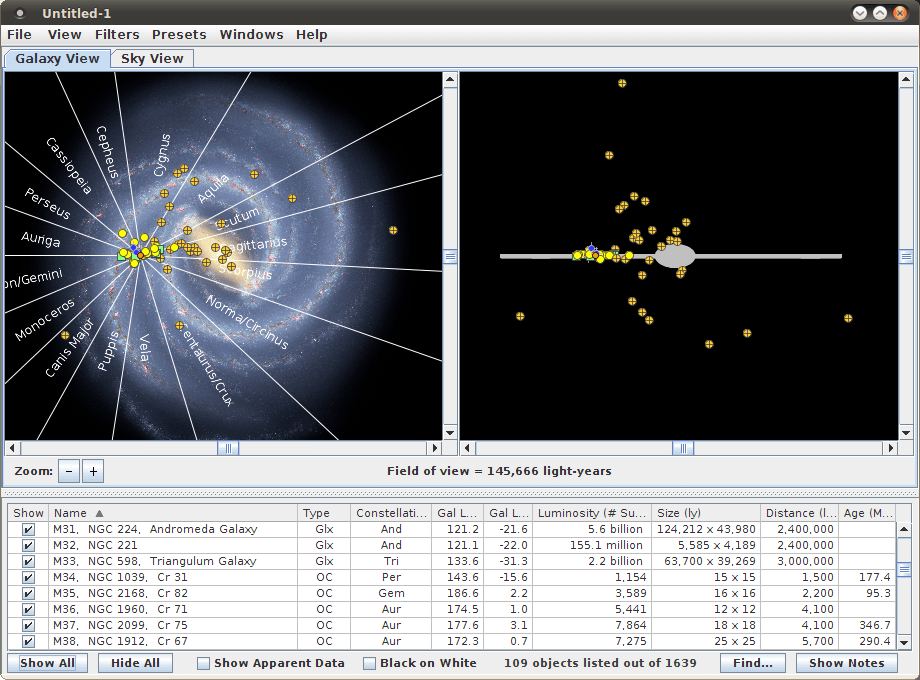Last Updated on July 13, 2021
Where is M13? helps you visualize the locations and physical properties of deep sky objects in and around the Galaxy.
Using paired face-on and edge-on views of the Galaxy, this application shows you where that cluster or nebula is actually located relative to the center and plane of the Galaxy — a three-dimensional perspective.
Where is M13? is useful for both at home and in the field. At home, used together with a star atlas or observing guide, this software helps visualize the 3D nature of the Galaxy. In the field, it can enhance your viewing experience by supplying the missing third dimension to your 2D telescopic or binocular views. Where is M13? is particularly useful during public outreach events for explaining the large scale structure of the Galaxy and showing guests where the objects they view are actually located.
Features include:
- Galaxy View shows you paired face-on and edge-on views of the Galaxy. It uses the new “two armed” rendition of the Galaxy fro Spitzer.
- Sky View displays the night sky as plotted using galactic coordinates. This system helps users to see where deep sky objects and familiar stars are located relative to the plane of the Galaxy.
- Object List lists the deep sky objects in the database that match the filters you have set.
- Presets – allows you to open “preset” documents. Presets are documents placed in one of two specific directories.
- Zooming in and out with very fine controls.
- Filters Menu is used to choose which objects in the database are displayed in the Object Table
- Uses a number of important sources, like the Messier catalog and a few others.
- Cross-platform support – works with Linux, Mac OS X, and Windows operating systems. The software uses Java.
Website: www.thinkastronomy.com/M13
Support:
Developer: Think Astronomy
License: Freeware

Where is M13? is written in Java. Learn Java with our recommended free books and free tutorials.
| Popular series | |
|---|---|
| The largest compilation of the best free and open source software in the universe. Each article is supplied with a legendary ratings chart helping you to make informed decisions. | |
| Hundreds of in-depth reviews offering our unbiased and expert opinion on software. We offer helpful and impartial information. | |
| The Big List of Active Linux Distros is a large compilation of actively developed Linux distributions. | |
| Replace proprietary software with open source alternatives: Google, Microsoft, Apple, Adobe, IBM, Autodesk, Oracle, Atlassian, Corel, Cisco, Intuit, SAS, Progress, Salesforce, and Citrix | |
| Awesome Free Linux Games Tools showcases a series of tools that making gaming on Linux a more pleasurable experience. This is a new series. | |
| Machine Learning explores practical applications of machine learning and deep learning from a Linux perspective. We've written reviews of more than 40 self-hosted apps. All are free and open source. | |
| New to Linux? Read our Linux for Starters series. We start right at the basics and teach you everything you need to know to get started with Linux. | |
| Alternatives to popular CLI tools showcases essential tools that are modern replacements for core Linux utilities. | |
| Essential Linux system tools focuses on small, indispensable utilities, useful for system administrators as well as regular users. | |
| Linux utilities to maximise your productivity. Small, indispensable tools, useful for anyone running a Linux machine. | |
| Surveys popular streaming services from a Linux perspective: Amazon Music Unlimited, Myuzi, Spotify, Deezer, Tidal. | |
| Saving Money with Linux looks at how you can reduce your energy bills running Linux. | |
| Home computers became commonplace in the 1980s. Emulate home computers including the Commodore 64, Amiga, Atari ST, ZX81, Amstrad CPC, and ZX Spectrum. | |
| Now and Then examines how promising open source software fared over the years. It can be a bumpy ride. | |
| Linux at Home looks at a range of home activities where Linux can play its part, making the most of our time at home, keeping active and engaged. | |
| Linux Candy reveals the lighter side of Linux. Have some fun and escape from the daily drudgery. | |
| Getting Started with Docker helps you master Docker, a set of platform as a service products that delivers software in packages called containers. | |
| Best Free Android Apps. We showcase free Android apps that are definitely worth downloading. There's a strict eligibility criteria for inclusion in this series. | |
| These best free books accelerate your learning of every programming language. Learn a new language today! | |
| These free tutorials offer the perfect tonic to our free programming books series. | |
| Linux Around The World showcases usergroups that are relevant to Linux enthusiasts. Great ways to meet up with fellow enthusiasts. | |
| Stars and Stripes is an occasional series looking at the impact of Linux in the USA. | |